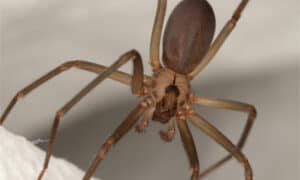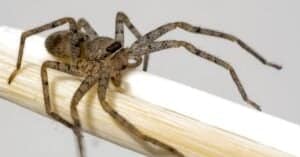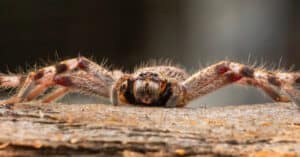Deep in the woods of Yellowstone National Park, numerous species of wildlife exist in harmony with their surrounding environment. Among these animals are a variety of spiders – including twelve unique species of black spider.
From jumping spiders to their wolf spider cousins, these daring arachnids may look intimidating but many of them are actually quite harmless. Learn more about these creatures by discovering the twelve species of black spiders found in Yellowstone – plus, whether they’re dangerous or not.
As the second largest recreational park in America, Yellowstone National Park sits on a 3,472 square-mile piece of land and extends to three states. The park boasts a rich biodiverse ecosystem that comprises hundreds of insect species.
Black spiders are among the most common invertebrates you’ll find in this park. While most are harmless, some black spiders have deadly venoms that could harm human health. This post highlights twelve black spiders crawling around Yellowstone National Park and assesses their propensity for danger.
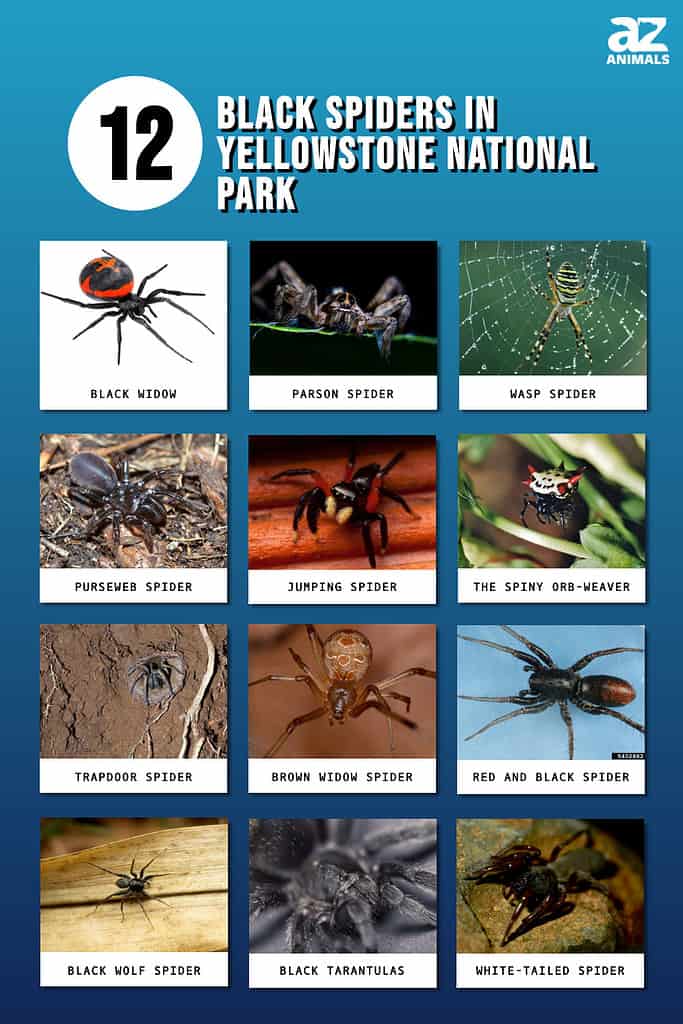
Black Widow
Black widows (Latrodectus spp.) are tiny spiders with oval-shaped abdomens and shiny black bodies. These spiders can grow to around 0.3 to 0.6 inches long, have long spindly legs, and form irregular web structures with multiple layers.
In Yellowstone Park, you’ll likely encounter black widow spiders under rocks or inside burrows and crevices. Their distinguishing features include an hourglass-shaped abdomen and distinct red markings on the underside. These markings and patterns are more visible in female black widow spiders than males.
Also, all black widows are inherently dangerous when provoked. The female black widow is the most aggressive and can deliver a nasty bite, containing neurotoxic compounds that paralyze the nervous system.
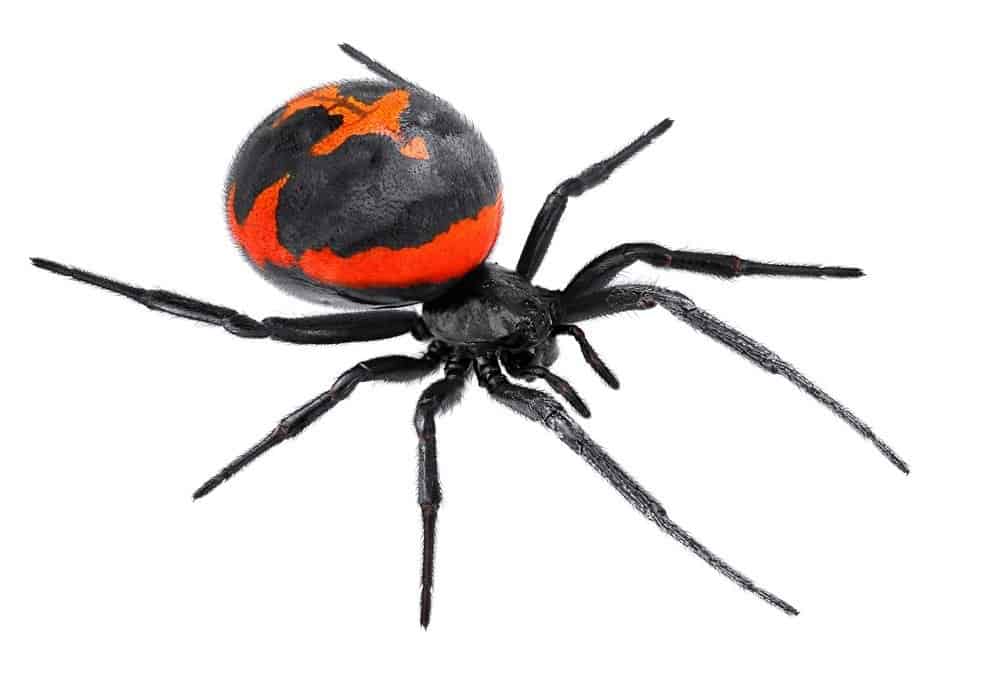
Though black widows can be dangerous if not handled properly, these spiders are still an important part of the park’s ecosystem.
©Protasov AN/Shutterstock.com
Parson Spider
The parson spider, scientifically known as Herpyllus ecclesiasticus, is black with a white stripe on its abdomen that resembles a cravat – a neckband worn by clergy members. Most parson spiders have medium-sized lengths of about 0.4 and 0.2 inches.
These species also have bright-coloured cephalothorax, hairy bodies, and red-brownish legs and are wickedly faster than other spiders. Rather than use webs to trap their prey like most spiders, parson spiders chase down their food.
You can find parson spiders lurking under rocks, logs, and debris in Yellowstone Park. While they’re generally harmless and their bite isn’t lethal, people with allergic reactions to spider bites can experience adverse side effects after being bitten by a parson spider.
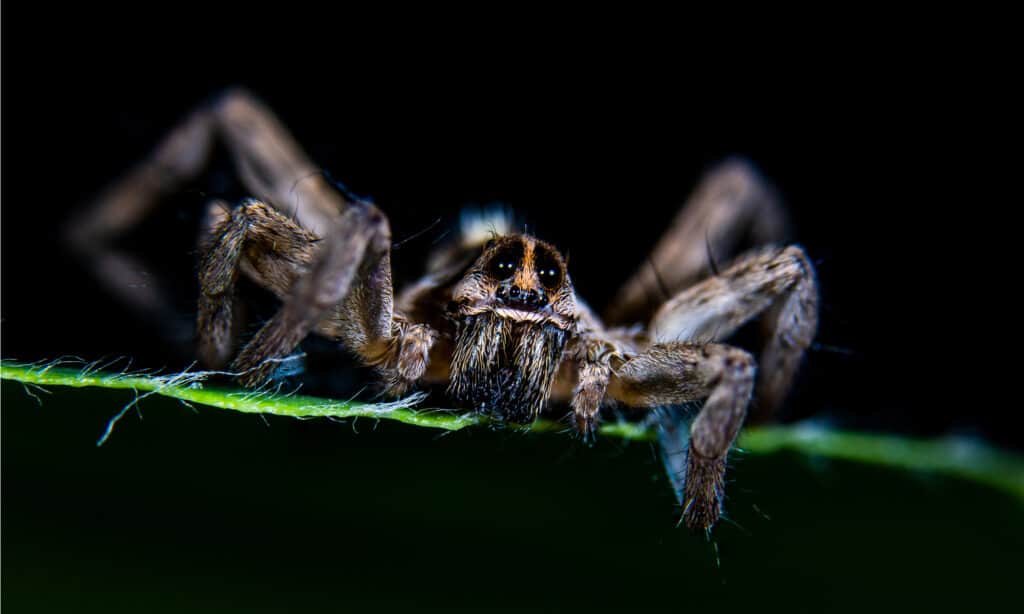
Parson spiders are harmless arachnids commonly found among the various landscapes and can usually be identified by their distinctive black-and-white patterned body.
©Kerry Hargrove/Shutterstock.com
Wasp Spider
Also known as Argiope bruennichi, wasp spiders are black with yellow stripes, similar to a typical wasp. Although non-indigenous, these species occasionally appear in parts of Wyoming, including Yellowstone National Park.
The male spider wasp measures about 0.15 inches long, whereas female wasp spiders can grow up to 0.8 inches. Besides the black and yellow stripes, you can distinguish wasp spiders by their X-shaped legs that overlap each other.
Inside the park, wasp spiders can be found in low vegetation areas, where they usually form orb-shaped webs to trap their prey. They’re generally non-aggressive and often respond to confrontation by hiding.
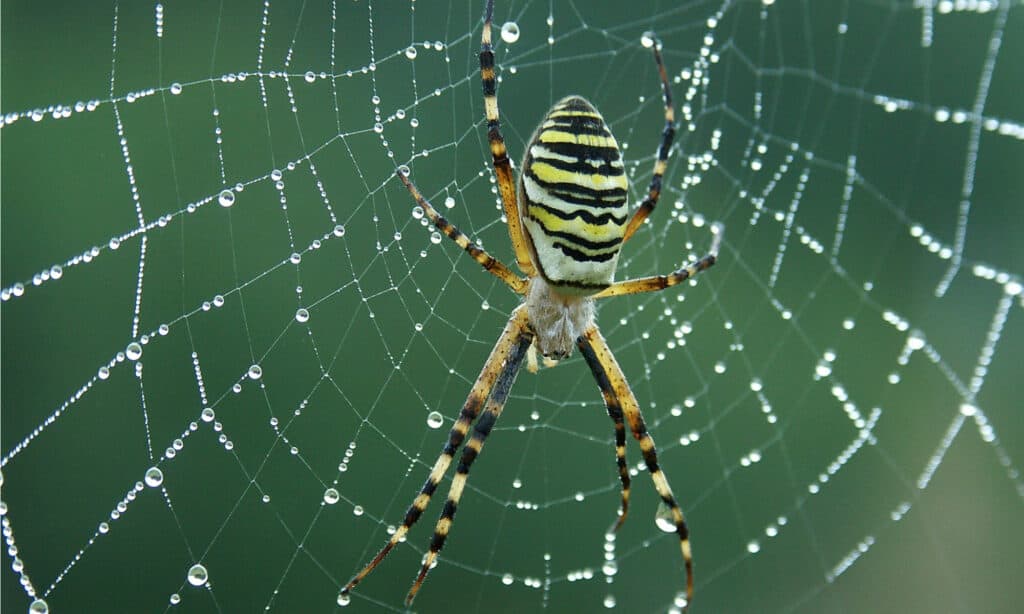
The wasp spider found in Yellowstone National Park is generally not considered harmful to humans.
©Violart/Shutterstock.com
Purseweb Spider
Purseweb spiders, or Atypus affinis, are medium-sized spiders with dark-colored bodies resembling the black widow. These spiders also have sprawling legs, fangs, and oversized chelicerae, with eight legs divided between their two main body segments (cephalothorax and abdomen).
The average size of a purseweb spider is 0.6 inches, with the female species being relatively more significant than male spiders. While you’ll rarely see purseweb spiders during the day, you can quickly identify them by their protruding fangs and shiny black body.
You can find purseweb spiders hiding under debris and cracked spaces around the park, designing silk tubing traps for their prey. Their bite is relatively harmless to humans but can cause allergic reactions in people sensitive to insect or spider bites.
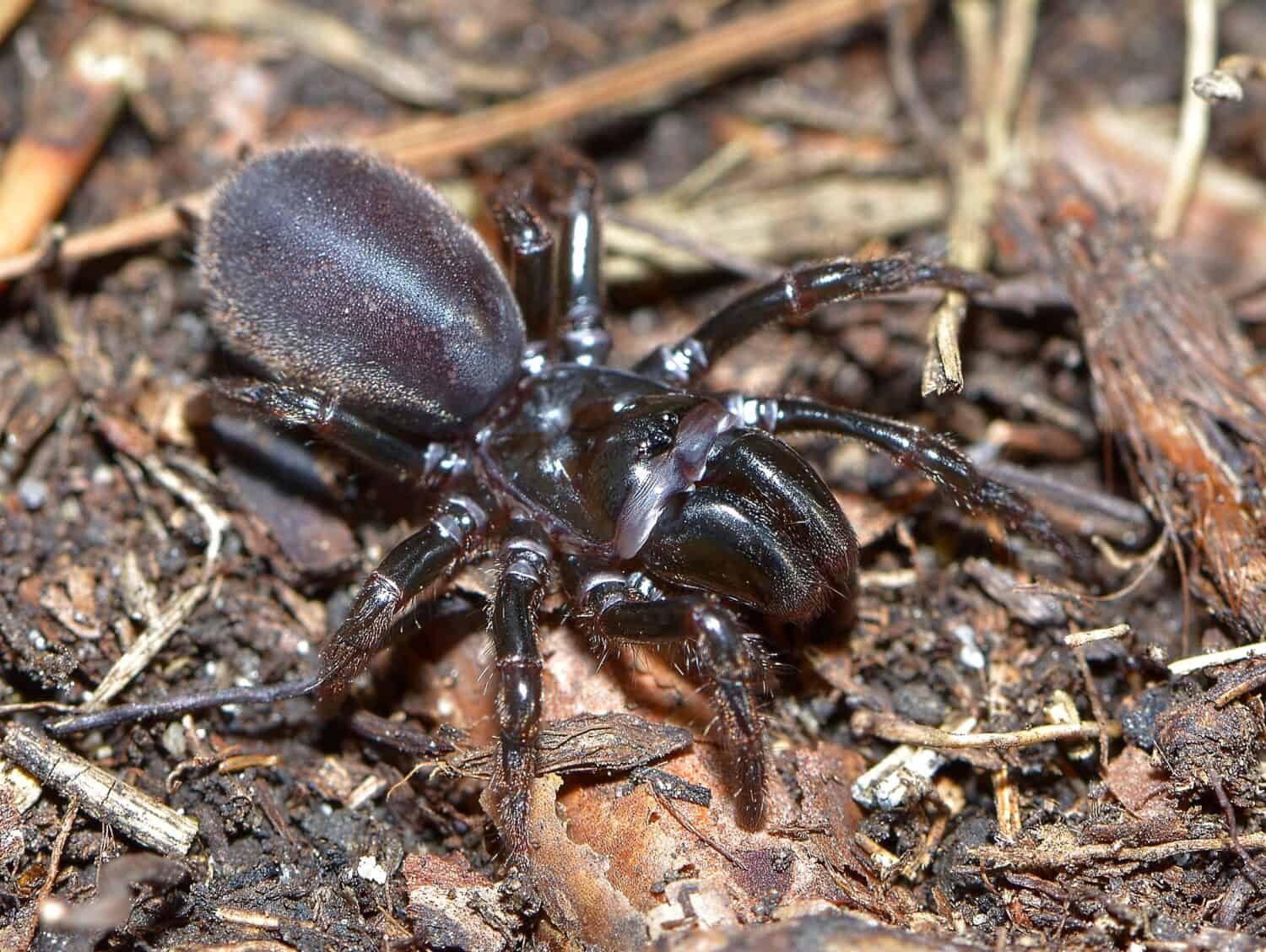
While it may look intimidating with its black coloring and long legs, purseweb spiders are harmless to humans and should be admired from a safe distance.
©Tobias Hauke/Shutterstock.com
Jumping Spider
Jumping spiders have short legs and compact bodies covered with dense hair. Their body color varies, depending on the species type. Some jumping spiders are entirely black, while others have variations of brightly colored scales on their bodies. The most common jumping spiders in Yellowstone National Park are:
Bold Jumping Spider
Bold jumping spiders or Phidippus audax have large round black abdomens with orange (for juveniles) and white markings (for adults). They’re typically 0.7 inches long and have black furry legs with dark gray bands.
Furthermore, most bold-jumping spiders are not inherently dangerous to humans. They hide in cracks and structures and stalk their prey before pouncing on them. The distinguishable features of a bold jumping spider are its flat face, big round, protruding eyes, and iridescent mouthparts.
Redback Jumping Spider
The red-back jumping spider has a bright red abdomen, a black cephalothorax, and black legs. These species can grow up to 0.16 inches long, and their legs are slightly longer than their bodies.
You can easily spot redback jumping spiders by their bright-colored abdomen. Female red-backed jumpers also have a central back stripe on the abdomen, while males don’t. Most jumping spiders are generally harmless to human beings unless provoked, after which they may respond by biting.
Zebra Jumping Spider
The zebra jumping spider, scientifically known as Salticus scenicus, is a black furry spider with a white stripe on its back. The white line on their abdomen distinguishes them from other black species, plus their spiny legs, large eyes, and fuzzy abdomen also give them a unique look.
Usually, adult zebra jumping spiders grow to about 0.4 inches long on average. They hide in burrows and crevices and stalk their prey from these locations. The distinguishing features of zebra jumping spiders are furry and brightly colored abdomens and fine hairs with white markings on the legs. Also, zebra jumping spiders are harmless and generally afraid of human presence.
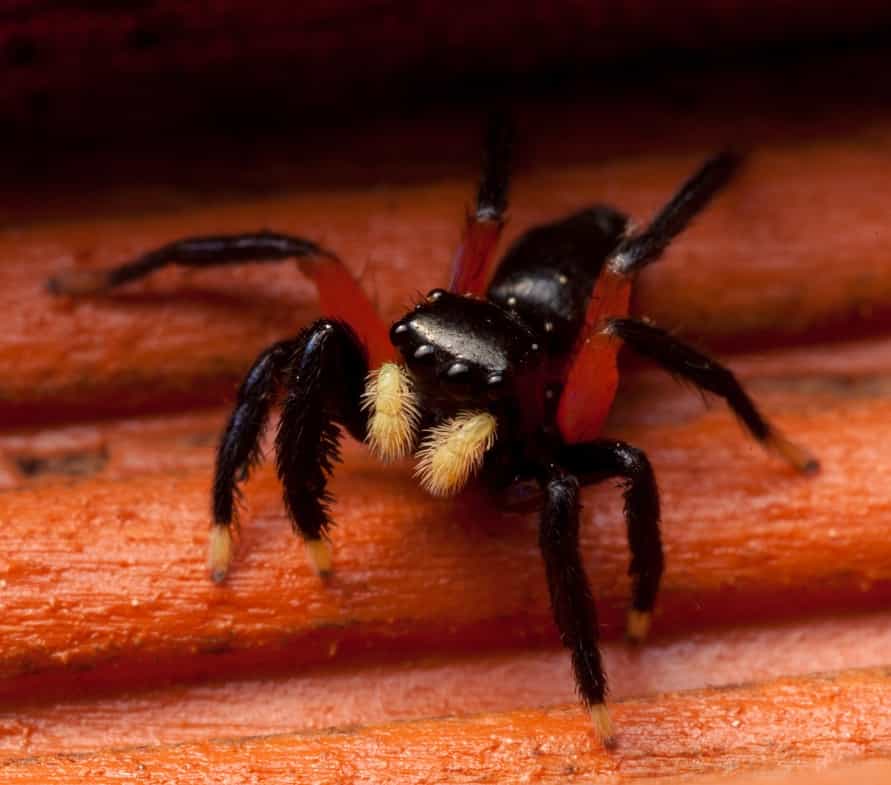
Don’t be alarmed! Jumping spiders are harmless to humans, and can often be found scurrying around the rocky terrain of Yellowstone National Park.
The Spiny Orb-Weaver
Spiny orb-weaver spiders, or Gasteracantha cancriformis, are black, colorful spiders with a distinct appearance from other black spiders. These species have circular disc-like abdomens and a mixture of bright colors, such as red, yellow, or white, and spots of black.
The female spiny orb-weaver is the longest, at about 0.4 inches, while the male species are around 0.1 inches. You can come across the spiny orb-weavers hiding under shrubs and leftover debris around the park.
While they do bite, spiny orb-weavers are generally less aggressive unless provoked. Also, their bite isn’t poisonous and does not affect the human body.
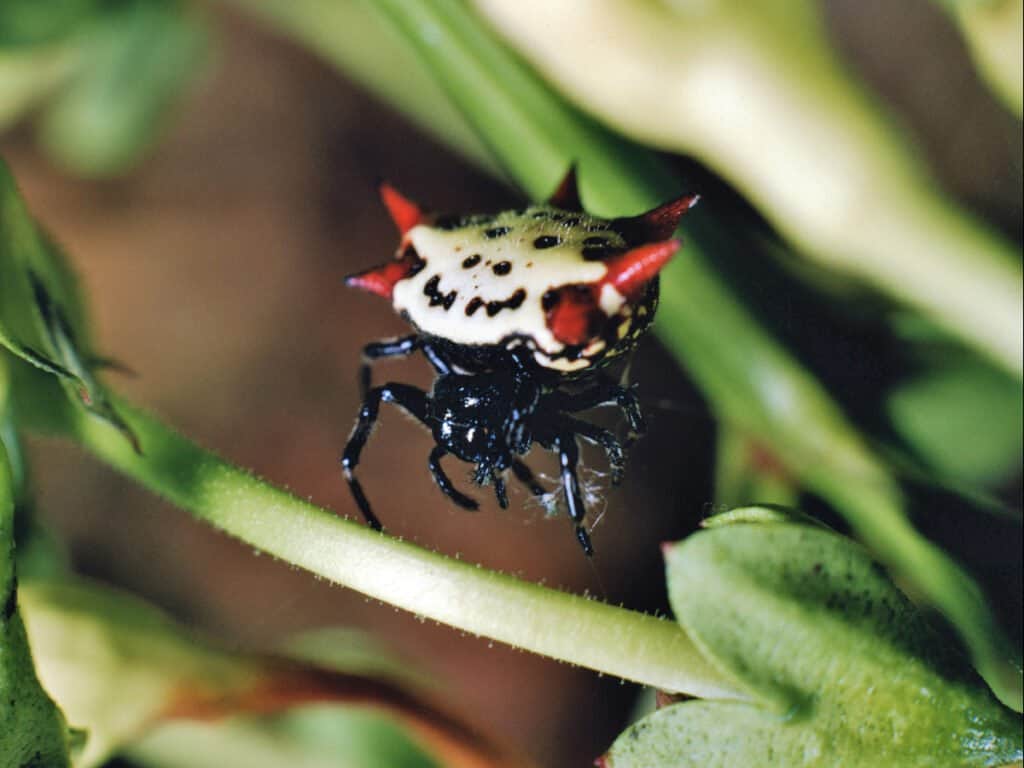
The spiny orb-weaver is non-venomous and harmless to humans, making it an interesting and unique addition to the park’s wildlife.
©iStock.com/Weber
Trapdoor Spider
Trapdoor spiders have a fascinating appearance. Their bodies have a mix of colors, ranging from black to yellow and brown, and they also have patterns on their abdomen. These features make trapdoor spiders easily identifiable from other black spiders.
On average, the length of a trapdoor spider is about 0.1 inches, but some females can measure up to 0.4 inches. The front legs of trapdoor spiders are also naturally more extensive than those at the back.
During the day, it’s almost impossible to see a trapdoor spider in the park since they’re nocturnal. These species spend most of their day hiding in burrows and crevices and only come out to hunt at night.
A bite from a trapdoor can be painful, but it isn’t lethal to human health. Trapdoors also rarely attack humans unless threatened or provoked, and they mainly feed on insects and other smaller prey.
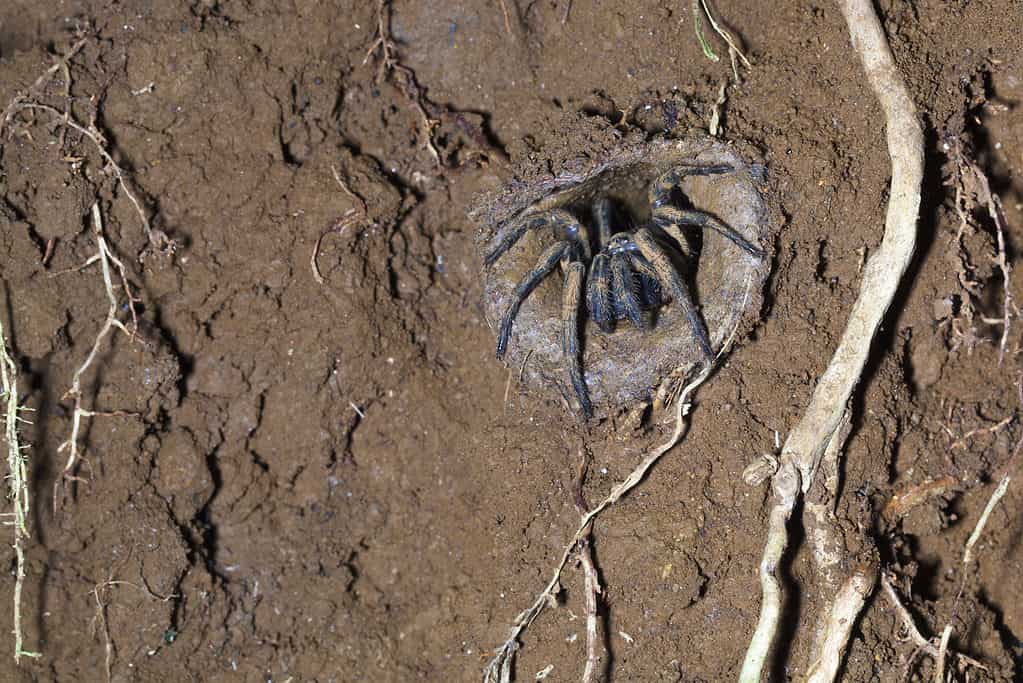
Unlike other spiders, the trapdoor spider lives in underground burrows and closes its entrance with a hinged door made of silk, soil and vegetation.
©iStock.com/zstockphotos
Brown Widow Spider
The brown widow spider, or Latrodectus geometricus, is a species that resembles the black widow. From its oval-shaped body to its venomous bite, every aspect almost resembles the black widow. The only distinguishing characteristic of the brown widow spider is its black-brown color.
Brown widow spiders also have abdomens with various patterns, spots, and stripes. A typical female brown widow can grow up to 0.6 inches, while male species can reach 0.3 inches as fully-grown adults.
You can spot brown widow spiders under rocks or inside crevices and other outdoor structures around the park. They form irregular webs at various strategic points to increase their chances of catching their desired prey.
Finally, brown widows are less aggressive than black widows when provoked. These spiders also have less lethal bite than the black widow, but their venom is still potent. The common symptoms experienced after being bitten by a venomous brown widow spider include nausea, muscle cramps, and localized pain.
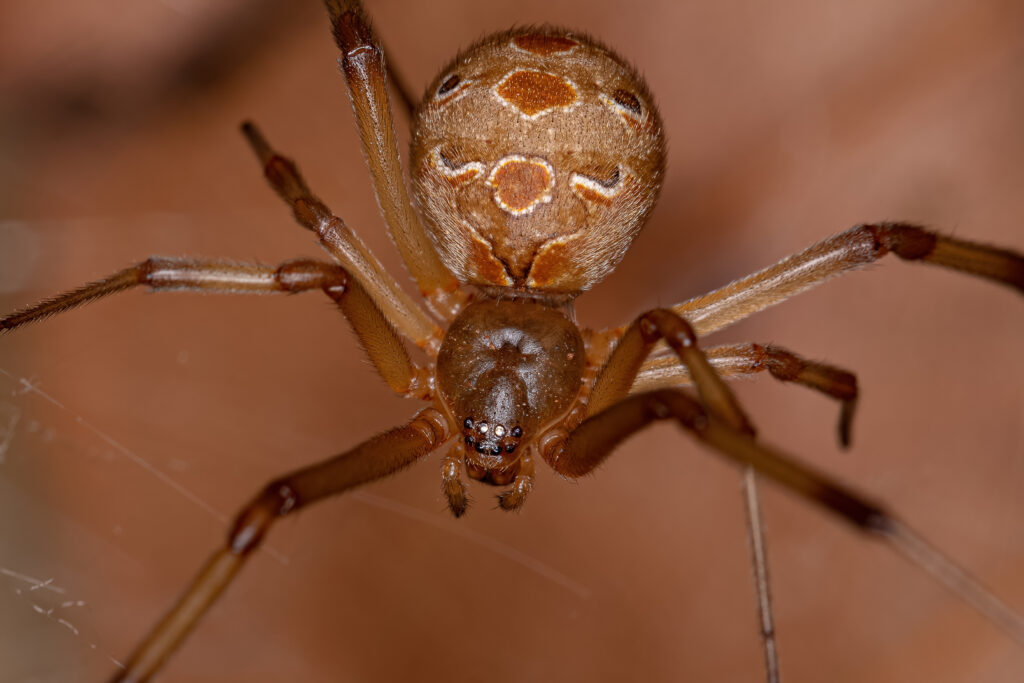
Brown widow spiders have abdomens with various patterns, spots, and stripes.
©iStock.com/ViniSouza128
Red and Black Spider
Red and black spiders fall under the genus Theridion. The male species of these spiders grow to about 0.15 inches, while their female counterparts can be about 0.45 inches long when fully grown.
Also, most red and black spiders have distinguishable markings on their abdomens. These markings can be colored red or orange and are more visible in female red and black species than in male spiders.
Danger-wise, red and black spiders have a lethal bite with deadly venom. The side effects of getting bitten by a red and black spider bite include interrupted breathing and abdominal and muscle pain. Some examples of red and black spiders that you can encounter in the park include:
- Theridion grallator or the Happy Face Spider: Also known as the smiley face spider, this species of red and black spider has a distinctive orange patch in the abdomen with a black border surrounding it.
- Theridion mystaceum or the Red-spotted Mimic Ant Spider: These spiders have a black body with red or orange patterns on the abdomen. They resemble the appearance of specific ants, hence their name, red-spotted mimic ant spider.
- Theridion impressum or the Red-spotted Spider: This red and black spider has red spots on the abdomen and a shiny black body. Its legs usually have sharp edges that resemble the comb – a primary characteristic of the (Theridiidae) family.
The red and black spider lurks in crevices or under rocks and logs across the park. Always avoid red and black spiders due to their venomous bite. However, they rarely attack unless provoked, even if you cross their path.
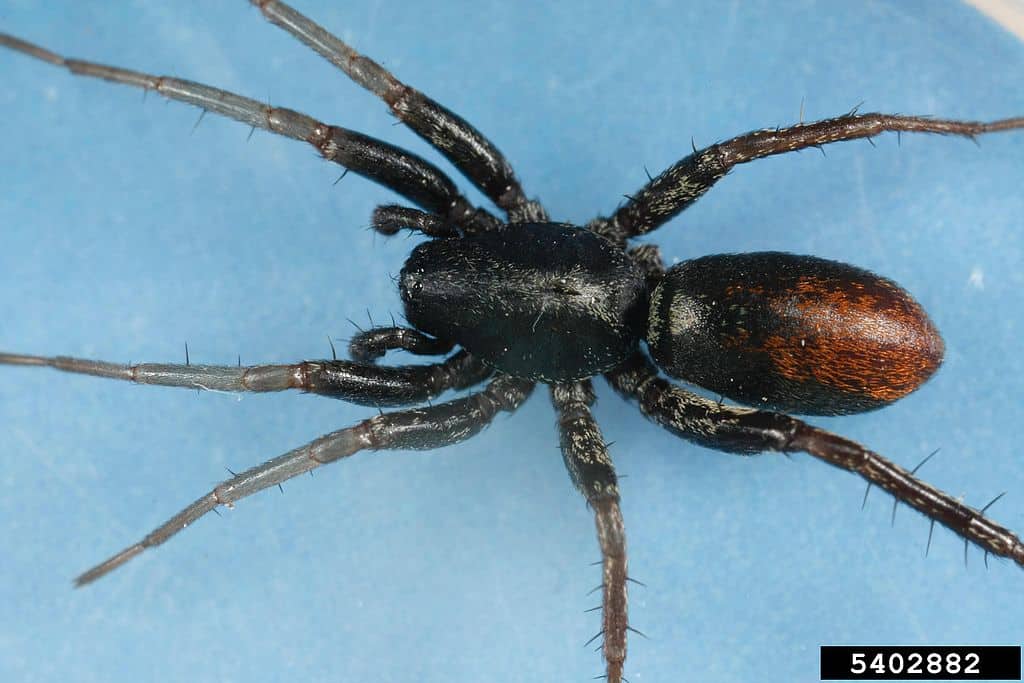
The red-spotted mimic ant spider (
Mimetus lapidicola) has a black body with red or orange patterns on the abdomen.
©Joseph Berger, Bugwood.org; University of Georgia / CC BY 3.0, via Wikimedia Commons – Original / License
Black Wolf Spider
Black wolf spiders are a popular species of the Lycosidae family. They have a dark brown appearance, with some wolf spiders also showing patterns and markings on their abdomens.
The eight eyes of a black wolf spider are uniquely arranged in three rows. The two larger central eyes are in the front area for good vision, while the less visually clear ones are in the back layers.
You can find black wolf spiders on the ground in natural crevices or burrows that they design for hiding. Like parson spiders, black wolf spiders hunt down their prey through sheer speed and vision.
They also eat insects and smaller invertebrates only and don’t consider humans as a general threat unless provoked. Overall, the bite of a black wolf spider doesn’t pose a significant threat to human life unless you’re sensitive to spider bites.
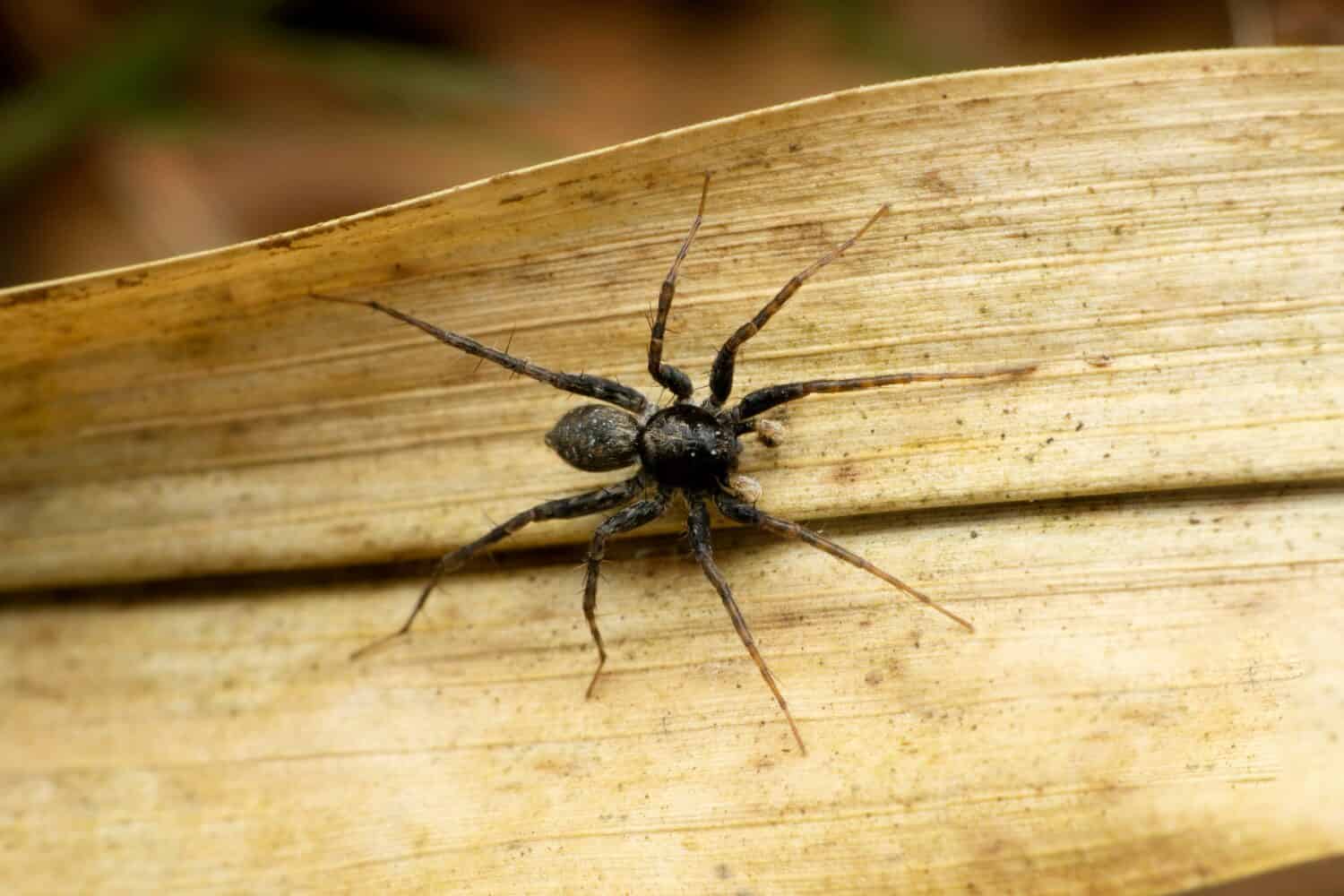
A black wolf spider’s powerful venom can harm other insects and small animals.
©RealityImages/Shutterstock.com
Black Tarantulas
Yellowstone National Park is home to different types of black tarantulas. Most tarantulas have different markings on their bodies, and their sizes range from a couple to several inches, depending on the species.
Black tarantulas also have long legs that can extend several inches. Instead of chasing their prey, they use slow, deliberate movements to catch their game and inject venom through their lethal bite. The common types of black tarantula species available in the park are:
- Grammostola pulchra – This popular tarantula species has a relatively black appearance and a furry body. They’re mainly known for being aggressive and defensive even at the slightest provocation.
- Cyriopagopus sp. – Also known as the “Hati Hati” black tarantula species, this spider has a shiny dark appearance. It usually hides under burrows or crevices and stalks its prey before pouncing.
- Haplopelma minax – This tarantula has a cobalt blue appearance, especially around the legs. Its blue color, and black abdomen give it a striking appearance that is notable from a distance.
- Poecilotheria metallica – Also referred to as the Gooty tarantula, this species has a distinctive black and blue-cobalt color.
- Theraphosa blondi – This is one of the largest tarantula species in the world. It has a black, brown appearance with reddish hairs on its abdomen.
Most tarantulas appear in Wyoming when it’s warm instead of the cold season. They usually hide in burrows and crevices during the daytime and hunt at night.
Tarantulas also crawl under logs or small shrubs and vegetation across the park. While they are good at camouflaging, you can quickly spot a black tarantula by its hairy body and stripes of markings and patterns.
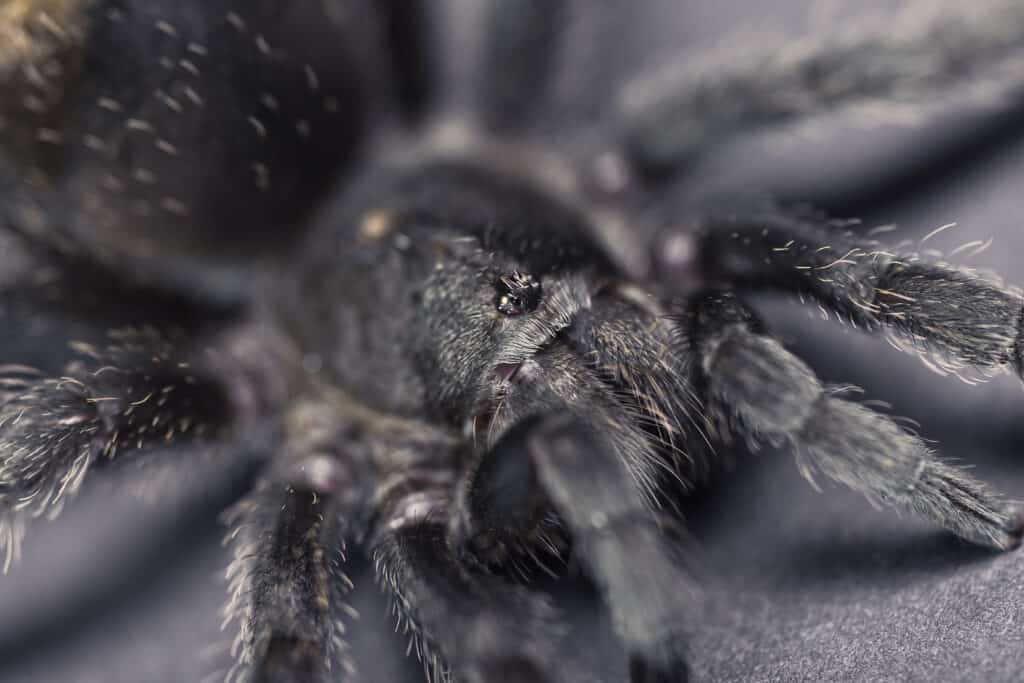
Despite their intimidating appearance, tarantulas are not considered dangerous to humans and can often be found crawling around park trails and boardwalks.
©iStock.com/skydie
White-tailed Spider
White-tailed spiders have a black cephalothorax and long white stripes along their abdomen. They can grow up to 1.8 inches long, and their legs often extend another 1.2 inches from the body.
In Yellowstone National Park, white-tailed spiders can be found in dark spaces, such as under logs, fallen debris, and vegetation. Although their bite is venomous, it’s not harmful to human health. The most severe signs experienced after a white-tailed spider bite are swelling, pain, and itchiness. You can spot a white-tailed spider by its distinct white-colored tip on the abdomen.
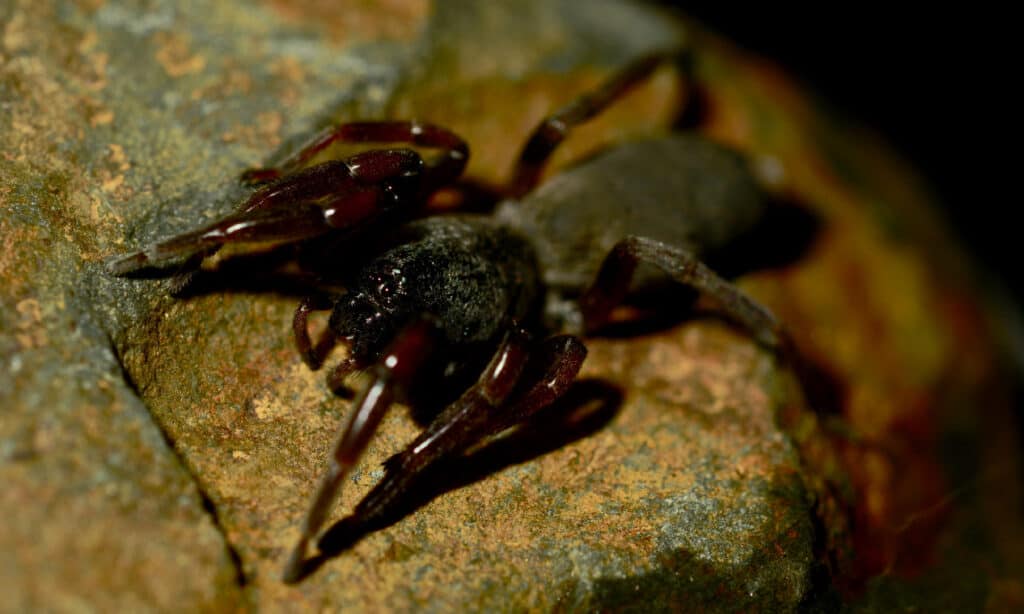
The white-tailed spider feeds mainly on other small insects, so you don’t have to worry about them when exploring the park.
©iStock.com/Natalia Marshall
Learn More About the Different Types of Spiders in Yellowstone National Park, Wyoming
Visiting the majestic Yellowstone National Park in Wyoming, you will find a wide variety of animals, including various types of black spiders. Before you plan your trip, it is important to have a basic understanding of these invertebrates, including how to identify and interact with them safely.
Across the internet, visitors can find helpful content that gives them insight into the different species of spiders living in the park, plus advice on how to best observe and appreciate them without disrupting the delicate ecosystem. Whether you’re a nature enthusiast or just curious about these creatures, there are extensive resources that will give you a better understanding of the lives of our eight-legged friends living in Wyoming’s wilds.
Yellowstone National Park provides a unique and diverse habitat for many species of spiders. From small and inconspicuous species like cobwebs and jumping spiders to predatory species like wolf spiders and fishing spiders, Yellowstone provides an ideal habitat for these species. Their population density and health are both excellent indicators of the overall ecosystem health. With their webs and colorful bodies, all the different types of spiders thriving in Yellowstone offer a unique experience for any park visitor.
Summary of 12 Black Spiders in Yellowstone National Park
| Number | Black Spider |
|---|---|
| 1 | Black Widow |
| 2 | Parson Spider |
| 3 | Wasp Spider |
| 4 | Purseweb Spider |
| 5 | Jumping Spider |
| 6 | The Spiny Orb-Weaver |
| 7 | Trapdoor Spider |
| 8 | Brown Widow Spider |
| 9 | Red and Black Spider |
| 10 | Black Wolf Spider |
| 11 | Black Tarantulas |
| 12 | White-tailed Spider |
The photo featured at the top of this post is © Heather Ruth Rose/Shutterstock.com
Thank you for reading! Have some feedback for us? Contact the AZ Animals editorial team.




